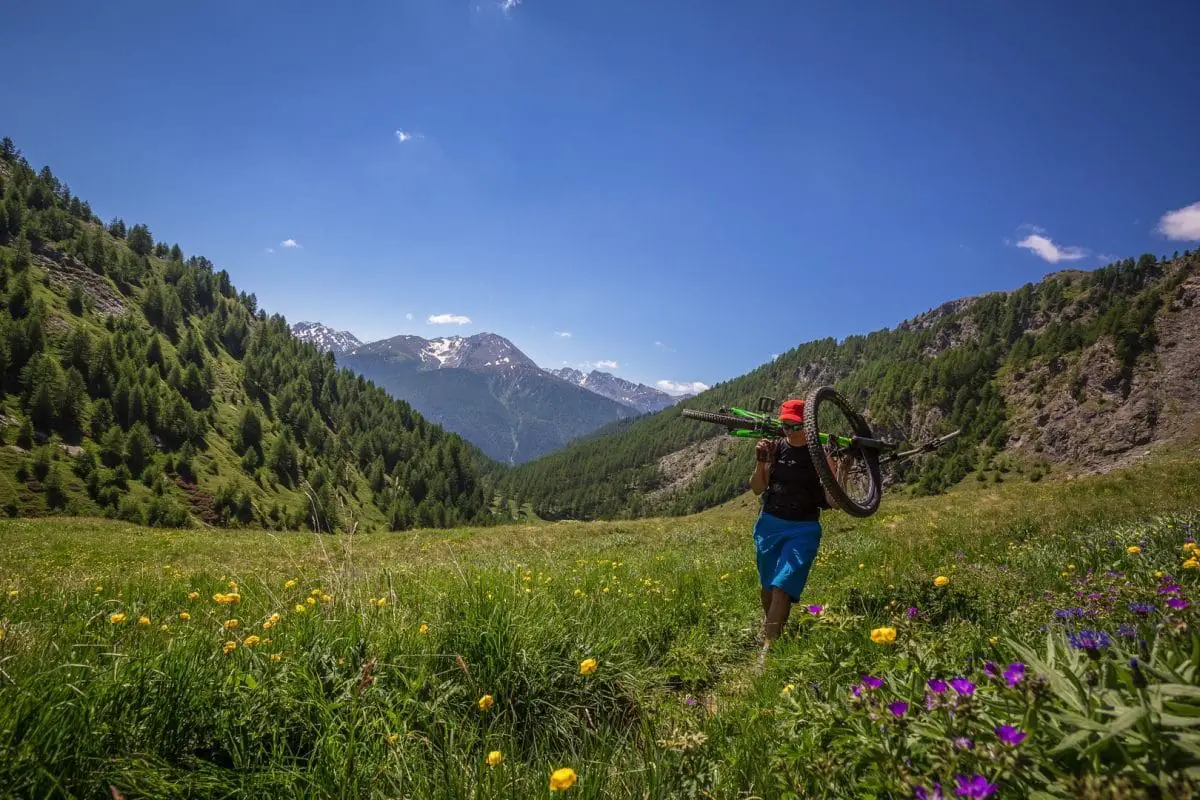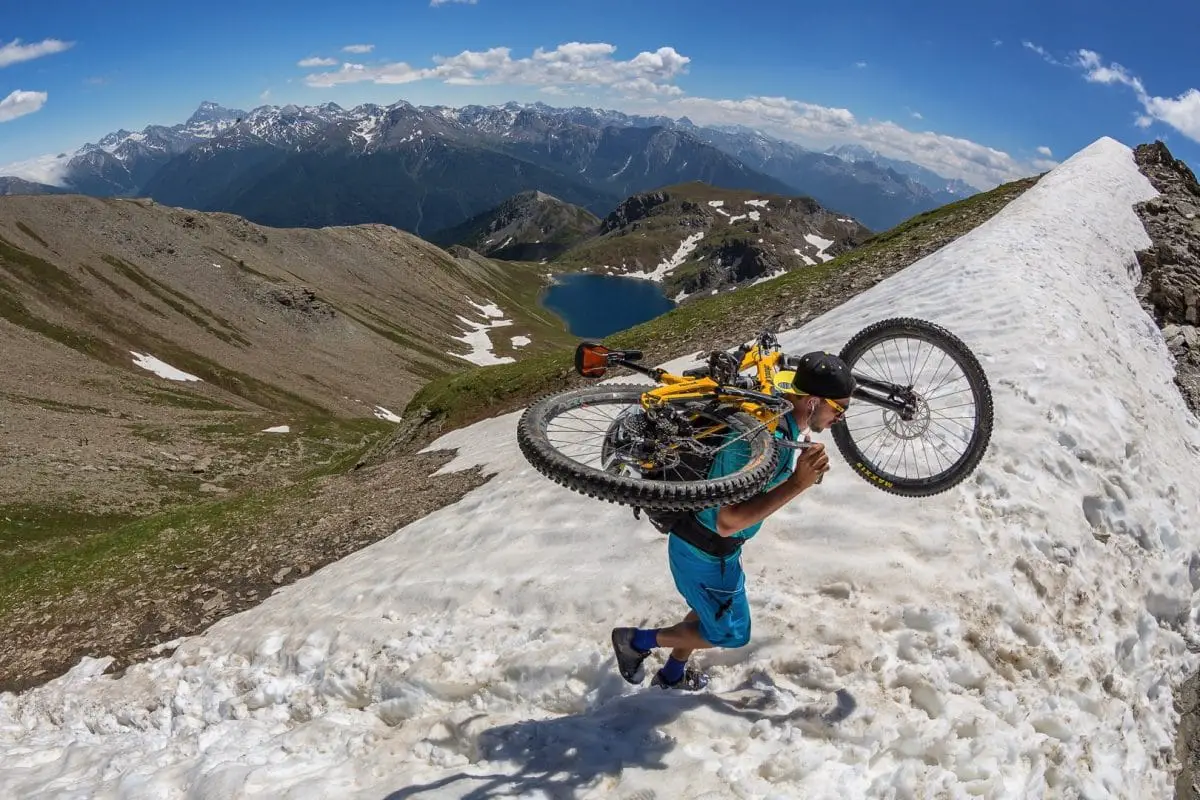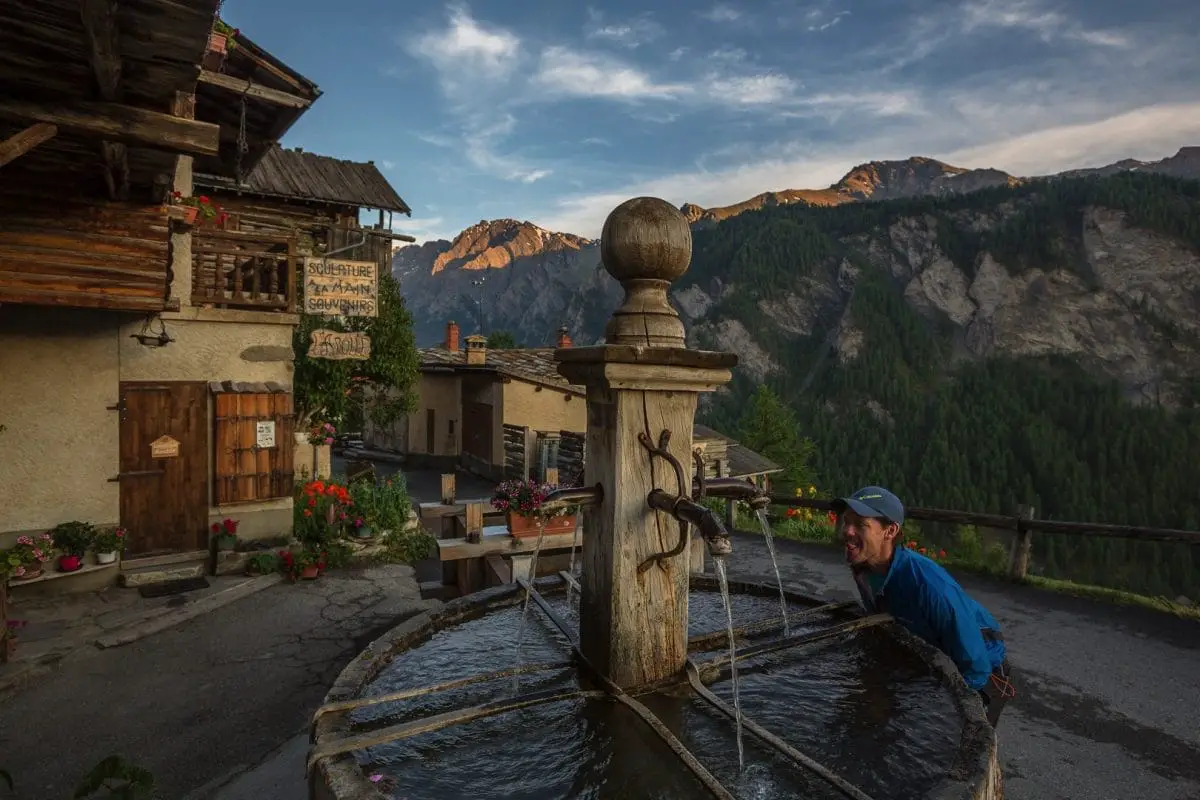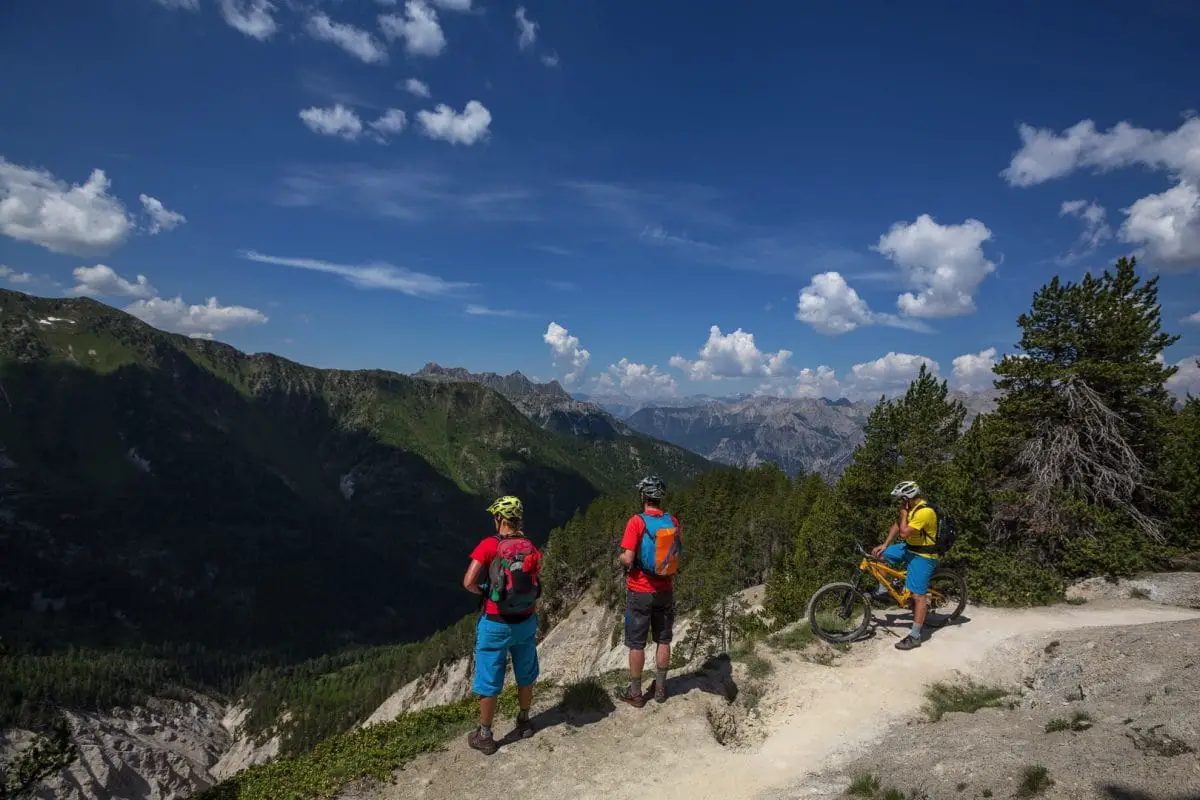This article was originally published in issue 115 of Singletrack Magazine.
Words & Photography Anthony Pease.
Turn your back on the uplifts of the Alpine honeypots and a whole world of adventure, hidden trails, mountain top restaurants (and endless hike-a-bike) awaits.
There had been childlike excitement building up over the previous few weeks. Texts and messages flying back and forth between Wales and France. Talk about kit choices, what tyres will be best, how and where will we eat, how much money will be needed, what’s the weather like in the Alps now? The questions just kept coming. It’s not like I haven’t been on an adventure before, hell, I’ve been on plenty. This time though I wasn’t organising it and, in all honesty, I’d done very little planning for what we were about to do. I’d merely booked some tickets to Geneva, packed my camera gear in my rucksack and filled any remaining space with what I hoped would be enough for a week’s riding.
Before I knew it, I was sitting on the floor of my friend’s flat in Bourg-Saint-Maurice surrounded by French IGN maps, Beaufort cheese and home brew. The previous week’s madness and stressful work commitments had already drifted away and the strong beer and pungent cheese was helping to relax the mind. The realisation I was at the beginning of an adventure truly sunk in. Mountain biking trips to the Alps usually begin by rolling off a plane, grabbing my bike bag and heading to Morzine for a week of gravity-based fun. This trip was going to be a little different from my previous Alpine mountain biking trips with a hint of the unknown, no lifts, a rucksack full of essentials, fuelled mainly by local saucisson and the free mountain water that pours conveniently into wooden troughs all over the mountains.
Powered by sausage.
The idea came about last year when my friend’s partner, Emily, who just happens to be a qualified mountain bike guide in France, discussed how she wanted to piece together a multi-day trip – a week’s riding that would take us away from the trail centres and into the mountains as they should be seen. The question, though, was where? There is an abundance of natural trails and hidden gems to be found all over the French Alps and, yes, we could have stayed near the hotspots and used chairlifts to win against gravity and ease the start to each day, but where’s the adventure in that?
The decision was made to head south and explore the Queyras National Park, an area just beyond Grenoble near to the Italian border, well known to hikers and the like, but not necessarily high on the hit list for mountain bikers. This was already sounding perfect to me. A little research before I left (mainly consisting of Google Images; I am a photographer after all), indicated this was an area of natural outstanding beauty, valleys full of wild flowers, remote villages and very few known mountain bike trails all nestled ruggedly inside a ring of 3,000m peaks.

Whose floor are we sleeping on?
So, things were looking good and the route was set – the next and rather important question was, where would we stay? We’d already decided to travel as light as possible and keep the weight off the bikes, so a standard bikepacking set-up was out of the mix. With this in mind, the only option would be to carry on our backs everything we needed for the trip.
We all know a heavy rucksack is no fun – add it to five consecutive days of riding and it would definitely not be a good idea, so pack weight had to be kept to a minimum.
Luckily the Alps are full of options for the lightweight traveller as there are the usually stunningly positioned mountain refuges, gites d’etape and hotels. As always, keeping costs down was high on the agenda, which brought us to what we felt was the right decision for this trip. Staying at gite d’etapes would provide beds, showers, dinner and breakfast, all for under €40 a night.
Mountain refuges would have been great, but can be more expensive and often have single room dorm-style sleeping arrangements, which see you shoulder to shoulder with 12 other smelly mountain lovers… no good for a light sleeper like myself. This only left the days either side of riding to find lodgings – we wanted to be near the start for the first day and stop in Briançon for the last day, mainly so we could eat out and have celebratory beers on completing our little adventure. We found both on good old Airbnb and dividing this between us this kept the cost low.
The last piece of the puzzle in our quest for adventure was how to get all of us, bikes and kit, to the start and then back to Bourg Saint Maurice again. Luckily, the fourth member of this newly formed mountain biking group was Rob, who just happens to own Cool Bus, a transfer company that works in and out of Geneva. I’d never met Rob before, yet within 24 hours it was apparent we would get on just fine. His choice of music, tales of riding with the likes of Rowan Sorrell, and his super-smooth riding style, made it easy for us to instantly become friends and I was looking forward to riding with and photographing him during the week.
Local beers for local pizzas.
Everything was now in place; bikes, bags and riders were all in the van and heading to our first stop for the night, a lovely Airbnb apartment in Eygliers, about an hour away from our starting point. After a fun first night eating our bodyweight in stone baked pizzas, drinking local beers and hiking round some rocks that became known as the Flared Nostrils of the South, it was time to haul the bikes out of the van and start spinning the pedals.
Instantly we were into a climb with over 1,100 vertical metres, which set the precedent for the week. Each morning started with a lung-busting and thigh-burning attack on the mountains to gain elevation. But unlike the rest of the week, this first day was relatively easy as it was on road and farm tracks. I should have savoured the moment a little more as at this point I had no idea that the following days would require me to push, carry, pull and grunt my way up hundreds, if not thousands, of metres of narrow singletrack climbs. If, like everyone else, I just had the minimum amount of kit needed for the trip, I would have been fine and could have hikeabiked most of the tough sections.
Unfortunately, my camera gear meant my pack was not only twice the weight of the others, but also a fair bit bigger. When throwing the bike on my back for the steep sections it dug into the top of my neck, rather than sitting on my shoulders and by the third day my back was shot. I resorted to pushing and hauling my bike behind the others when climbing the narrow and, often deep, trails. Luckily, regular stops to take on water and eat slices of saucisson briefly removed my thoughts from the pain and set me up for the next sections of unrelenting climbs. It wasn’t all doom and gloom, though, and, in all honesty, it didn’t ruin my trip one little bit. I always say you learn something from every experience and a painful one was learnt here… don’t be the photographer.
The climbing was tough, yes, but this just meant the descents were on the epic side. Kilometre after kilometre of winding, twisting, rocky singletrack that took us over fields of boulders, across snowfields, round switchbacks that would show up most bike parks, and along tight forest trails. It’s not often you can whip your bike down such an array of trails that have you screaming with joy for what seems like an eternity. Some days the descents were so long and technical we had to stop just to regain grip and composure; you know it’s good when your fingers start to seize up, forearms start to suffer and you can no longer feather the brakes as needed.
The plan to keep weight off the bikes so they retained their pre-designed qualities was paying off. Having bike bags fitted would have stopped us being able to pin the descents and made them harder to work with on the hikeabike sections.

You old gite.
The gites d’etape were a new deal for all of us, and what a superb experience they were. Each night we arrived to find rooms with clean beds, showers, and offerings of ice-cold beers (additional cost). Around 7pm we’d sit down to a three-course meal, often with hikers from all over France and the rest of Europe. The four we stayed at varied massively; here’s a breakdown of them in order of our trip:
Refuge des Fonts de Cervières
A refuge-style accommodation in Fonts de Cervières that had no mains power and ran on 12V lighting and gas. Although miles from anywhere it seemed to be a hotspot for the locals, with a traditional French Alps vibe. Its location set it apart from the rest with nothing around, but a mega-technical singletrack descent in to it and a great route out that gave panoramic views to remember forever.
La Teppio
A ground-floor bunkhouse-style accommodation near Arvieux that sat below the upper floors where the owners and family lived. That night will stay with me for a long time as I was nearly taken out by a free-falling kitten that plummeted from one of the upper balconies, whistling past my ear and landing by my foot with the most gut-wrenching thud I have ever heard. Luckily, although very shocked, it was OK and seemed to be looking happier by the time we left.
Gite d’etape Les Astragales
Large and very well equipped accommodation in the town of Château-Ville-Vieille. The basement where you eat is a bar area with a great selection of cold beers, wines and spirits – this place looked like it could cater for larger groups and help fuel some crazy night-time fun. It was here that a new style of Jenga was created, a version we coined ‘Redneck Jenga’.
Gite Les Gabelous
Saint-Véran is the highest commune in France at near 2,000m. This large old building is steeped in history and its quirky features include a wood-fired hot tub outside the front elevation of the property with a view towards the surrounding mountains. This was by far my favourite night and gite for many reasons. Firstly, we rode hard all morning to miss an incoming storm and on the switchback road section to the village I overtook a peloton of weathered roadies and inadvertently started a battle of Lycra vs. baggy shorts. I managed to hold off all bar one of them on the 2km climb into the town, admittedly I was blowing out my rear end but I wasn’t prepared to lose this battle. As we picked our way through the twisted roads within the town and finally laid our bikes against the wall outside the gite, the air changed, light faded and, within seconds, huge hailstones beat upon the roofs of the surrounding buildings, followed by the always impressive lightning storms these mountains like to share with us.
After another amazing three-course dinner, Dave, Rob and I took ourselves out for a beer-fuelled, self-narrated and, no doubt, rather incorrectly advised history tour of the village. Although this wasn’t the actual last night of the trip, it was the last gite we would stay at and for me it could not have been a better one.
And now, you pay.
The last day soon came and with it some truly punishing climbs. It was a day of memories, laughs and fatigue. Sitting on rocks at the Italian border under the scorching midday sun, we watched road cyclists excitedly loft bikes above their heads for photos while we ate the largest baguettes you have ever witnessed. With crumbs of fresh bread coating my entire body, I knew this was fuel for the last big push of the week. Topping out at 3,000m was going to be an awesome way to sign off on what had been a trip I’ll talk about for many years.
There it was, the last descent of the week. I was ready for this – my upper body was ready for this and my back was certainly ready for this. Rucksacks pulled in tight, knee pads on, we stood there, on top of the world. A group of friends, old and new, excitedly dropped seat posts, made contact with their pedals, and launched off into what could easily be a mega stage of the EWS. We floated down hardpacked ridges, down meltwater streams and through muddy bogs until we hit a tech-fest that would put a smile on any mountain biker’s face. This descent was up there with the best I have ever ridden and yet we were still only halfway down. Although my back was screaming and neck was in so much pain I was getting a headache, I still couldn’t stop smiling from ear to ear.
An hour later my arms were dead, my feet were sore and my face ached from grinning like a schoolboy in a sweet shop. We had done it! Five days of riding big hills, riding fast, riding loose, and riding some of the best trails in the Alps. Most importantly we had survived, not an injury between us apart from grazes and the usual scuffs the trail gives you along the way.
That night we stayed in the walled Citadel of Briançon, at 1,326m the highest town in France. This UNESCO World Heritage site is a must-see for anyone visiting the area, full of breathtaking history, architecture and restaurants.
Do it again?
So, what did we learn from this trip? Research is king – work out a route, have backup plans should you have an injury, the weather changes, or you run out of time. Pre-book accommodation as it can become busy in the summer months with hikers and cyclists. Local knowledge is a huge advantage and having a French mountain bike guide helped on many occasions.
Pack light – it’s surprising what you don’t need. Kit can be washed at night and will often be dry by morning. Most gites will make you lunch for a minimal cost and it will be fresher and tastier than what you might have been carrying from the start. Take cash, as some places still aren’t able to accept card payments. Most of all, surround yourself with good friends who have a similar riding ability as this is not terrain you want to be waiting around in or pushing yourself beyond your limits to keep up with faster friends.






















